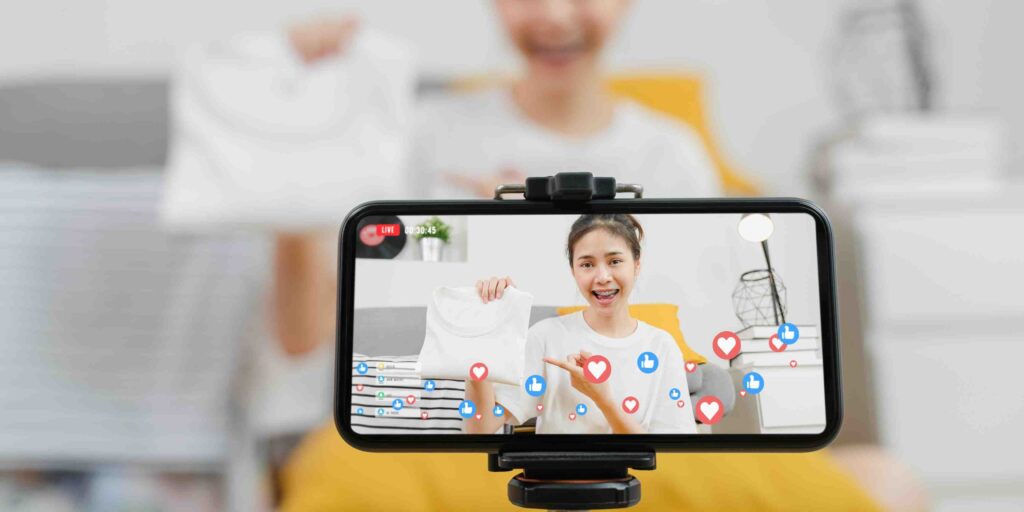Private live streaming is quickly becoming the preferred way for individuals and businesses to share events, stories, and experiences with their audiences. With technology evolving rapidly over the past few years, it has become easier than ever before to host private livestreams and connect with people through them. From interactive virtual studios to simple one-way broadcasts, private live streaming offers a variety of benefits that are sure to entice any business or individual looking for new ways of engaging their audience. In this article, we will explore the advantages of using private live streaming services as well as provide tips on how you can make sure your livestreams run smoothly.
Exploring the Advantages of Private Live Streaming

Whether you’re running a small business or trying to capture some special moments in your life, private livestreaming is an excellent way to reach out directly and engage with your target audience. Here are some key benefits of using private live streaming:
- Reach Out Directly: Unlike other forms of broadcasting such as radio or television, which broadcast content indiscriminately across distances, livestreaming allows you direct access with no interruption from third parties, ensuring no ads get in between your message and viewers.
- Cost Effective: Utilising professional equipment can be costly; however, livestreaming services are often offered in packages that include the necessary hardware and software to make sure you’re always running efficiently without spending too much.
- Total Control: Since it is a private event for your target audience, you have full control over who can view the stream, as well as when and how long they can access it.
- Cost Efficiency: One of the main advantages of using professional livestream services is their cost-effectiveness, since most providers offer different tiers of packages with various features included. This helps you save money while receiving quality streaming output.
- Real-time Interaction: Private live streams allow your audience to interact with each other in real time through chat functions, which bring people together during an event or conference more than ever before.
Understanding the Technical Aspects of Private Live Streaming
In order to ensure success with private live streaming, there are some technical aspects that must be taken into account beforehand, such as bandwidth, encoding settings, and bitrate optimisation, so that viewers have a smooth experience while watching your content. Here are some of the key elements involved in delivering a successful stream:
- Bandwidth: The amount of data capacity available for transferring files across a network connection will determine how quickly and smoothly your livestream is delivered to viewers.
- Codecs: These are algorithms used for encoding and decoding audio and video content in order to stream it from one device to another. Different codec formats are available depending on the type of live streaming service being used.
- Bitrate Optimisation: This refers to how much data is allowed for streaming a certain amount of video or audio content over a network connection within a given period of time. By optimising your bitrates, you can ensure that the quality does not drop even if there’s an increase in demand from viewers watching your livestream.
Tips for Maximising Quality During Private Live Streams
When hosting private live streams, it’s important that you take measures to ensure the best possible viewing experience for your audience. Here are some tips on how you can make sure that every live stream runs at its optimal performance level:
- Use High-Quality Equipment: The right hardware and software will help provide better visuals and sound effects during live streams, so be sure to invest in quality items when setting up your equipment.
- Test Your Setup Ahead of Time: Before starting any event, always run tests with different settings and configurations so that any issues can be fixed before going “live.”
- Utilise a Reliable Network Connection: To ensure that viewers don’t experience any buffering or lags during the livestream, use a reliable network connection with high speeds and low latency.
- Stay Up to Date: Keep your streaming software up-to-date so you can take advantage of all the latest features and improvements that come with new versions.
- Monitor Performance: Regularly monitor the performance of your stream in order to detect any irregularities or problems quickly before they become an issue for your viewers.
Pre-Production Considerations for Private Live Stream
Even if you have all the correct equipment and follow best practises, there is still more work involved in creating successful private live stream than just setting up a camera and audio system and going “live” on air. Here are some key pre-production considerations that every livestreamer should keep in mind:
- Have Clear Goals: Always set clear objectives about what you want to achieve through private live streaming so that you can plan accordingly and maximise efficiency when producing each event.
- Set Up Quality Lighting and Sound: Whenever possible, always opt for quality lighting equipment and sound systems, as having these properly configured will make sure you’re always delivering high-quality stream that look professional.
- Rehearse: rehearsing with your team before starting any event can help ensure everyone is on the same page when it comes to production and broadcasting.
- Have Backup Equipment: It’s always wise to have backup equipment prepared in case of emergency, as this will help minimise downtime and make sure you don’t miss out on important moments during the event.
Strategies to Monitor & Measure Performance with Private Livestream

Monitoring and measuring performance are key components for successful livestreamers, as it helps them understand where they need improvements or modifications for future events. Here are some strategies that can be used to keep track of their performances:
- Viewer Retention: Understanding how many people watched until the end of each live stream, known as viewership retention, provides valuable insights into what content may be more engaging than others, so adjustments can be made accordingly.
- Average Time Watched: Keeping track of how long viewers tend to stay tuned in or drop off gives a good indication of which parts were interesting enough to hold onto their attention and which parts need polishing up next time around. This data could also be compared against different regions or demographics to determine what works best in which venues.
- Maximum Concurrent Users: Knowing how many people are tuned into the livestream at any given time provides a good overview of production quality as well as helping understand viewership trends and other factors that could affect viewer numbers during peak hours.
How to Choose the Right Equipment and Software for Private Livestreaming
When choosing equipment and software for private livestream, it’s important to pick products that will work together seamlessly while also providing high-quality output. Here are some considerations when selecting the right items:
- Compatibility: Some equipment may only be compatible with certain types of software, so make sure your hardware can run with what you’re planning on using prior to committing to any purchases.
- Brands and Models: Different brands offer different features and price points, so do some research into them before investing in one particular model over another. Also look out for user reviews in order to get an idea of how reliable each product is from other customers who have actually used it previously.
- Features: Different models come equipped with different features such as low latency streaming, HD/4K resolution support, chroma key (green screen) capabilities, and more; always take these features into consideration when selecting the right hardware for your private livestream.
Best Practises for Engaging Your Audience During a Private Livestream
Monitoring and measuring performance are key components for successful livestreamers, as it helps them understand where they need improvements or modifications for future events. Here are some strategies that can be used to keep track of their performances:
- Viewer Retention: Understanding how many people watched until the end of each live stream, known as viewership retention, provides valuable insights into what content may be more engaging than others, so adjustments can be made accordingly.
- Average Time Watched: Keeping track of how long viewers tend to stay tuned in or drop off gives a good indication of which parts were interesting enough to hold onto their attention and which parts need polishing up next time around. This data could also be compared against different regions or demographics to determine what works best in which venues.
- Maximum Concurrent Users: Knowing how many people are tuned into the livestream at any given time provides a good overview of production quality as well as helping understand viewership trends and other factors that could affect viewer numbers during peak hours.
How to Choose the Right Equipment and Software for Private Livestreaming
When choosing equipment and software for private livestream, it’s important to pick products that will work together seamlessly while also providing high-quality output. Here are some considerations when selecting the right items:
- Compatibility: Some equipment may only be compatible with certain types of software, so make sure your hardware can run with what you’re planning on using prior to committing to any purchases.
- Brands and Models: Different brands offer different features and price points, so do some research into them before investing in one particular model over another. Also look out for user reviews in order to get an idea of how reliable each product is from other customers who have actually used it previously.
- Features: Different models come equipped with different features such as low latency streaming, HD/4K resolution support, chroma key (green screen) capabilities, and more; always take these features into consideration when selecting the right hardware for your private livestream.
Best Practises for Engaging Your Audience During a Private Livestream
Engaging with your viewers is one of the most important aspects of successful private live streaming, so here are some tips on how to interact effectively with people during an event:
- Arouse Curiosity: Tease upcoming segments or features in order to get people interested and excited about what’s coming up.
- Ask Questions: Involve viewers more actively by asking them questions related to the topic being discussed in order to create conversations and foster engagement between everyone tuning into the stream.
- Utilise social media: share snippets from each livestream on different social media platforms throughout, then invite those who watched it back over for more once it started airing.
- Enable live chat: Provide a space for viewers to have discussions amongst themselves, such as through comment sections or message boards, which really helps boost viewer participation levels during an event.
The Future of Private Livestreaming and Virtual Studios
Private livestreaming has opened up infinite possibilities for individuals and organizations hosting events, whether it’s through interactive virtual studios or one-way broadcasts. As technology continues to advance at lightning speed, many new features are being developed just about every day geared towards making private livestream more immersive experiences for viewers. These include novelties such as 3D avatars, augmented reality (AR) functions, and more. As the demand for these services increases over time, expect to see an influx of new products in the near future that will make private livestreaming even better than before.
FAQs:
Private live streaming is a way of broadcasting content directly to a select group of people or viewers by using various software, hardware, and services. This type of streaming allows you to host events or conferences without interference from third parties, ensuring that your message reaches its intended target audience without interruption.
There are several benefits associated with using professional livestreaming services, including cost effectiveness, total control over broadcasts, direct access to audiences without ads getting in between messages, and improved engagement through real-time interaction with viewers during events.
The exact type and model of equipment needed when setting up a professional stream will depend on how large your project is and what kind of output you’re expecting from it; at the very least, you’ll need a camera to capture footage, an audio system for sound quality, and a reliable network connection for streaming the content live.
The costs associated with hosting a private livestream depend on which services you opt for and what kind of features they include; typically, most companies offer different packages with different tiers, each providing unique features, so you can pick the one that best fits your budget.
Yes, there are several major technical aspects that must be taken into account before starting a stream, such as internet bandwidth (i.e., data capacity available), encoding settings (i.e., codecs used), bitrate optimisation (to make sure the quality doesn’t drop when more viewers tune in), etc.
Hiring professionals is usually recommended in order to ensure smooth delivery of content during events as well as provide various other advantages such as hardware installation and setup, pre-production preparation, rehearsal runs, etc.; however, if this isn’t an option or simply not within your budget, it is still possible to produce successful stream using the right resources and knowledge.
Here are some tips that can help make sure that each live stream runs at its optimal performance: Use quality equipment, test configurations before the event starts, have a reliable network connection with high speeds and low latency, stay up to date with streaming software versions, monitor performance regularly during broadcasts, and always interact with viewers in order to engage them even more.
There are several strategies for measuring performance, such as viewer retention (how many people watched until the end), average time watched (how long viewers stayed tuned in or dropped out), and maximum concurrent users (how many people were watching at any given time). By tracking these metrics, one can gain valuable insights into what works well and what needs improving when creating future events.
Engaging with your audience during an event is essential for keeping their interest throughout, so here are some ways to interact effectively: tease upcoming segments and features beforehand; ask questions related to the topic being discussed; share snippets from each livestream on social media platforms, then link them back to the event page; and enable live chat functions so viewers can have conversations amongst themselves.
With technology improving at an astounding rate, there are many new features being developed just about every day geared towards making private livestream more immersive experiences for viewers; these include novelties such as 3D avatars, augmented reality (AR) functions, and more. In short, expect to see a lot of exciting advancements in this space moving forward.

